Middle Ages and Fashion and Rich
Every bit in just well-nigh any other catamenia of history, habiliment in the Center Ages was worn for necessity, comfort, and brandish. Bright colours and rich decorations made for a striking medieval wardrobe, at least among the wealthy, although there was a surprising similarity in clothes for different social classes and the sexes. More than expensive items of vesture were generally distinguished not by their design merely by their use of superior materials and the cut. Governments sometimes intervened in who should wearable what and how much sure items were taxed while some members of the clergy, in particular, were frequently berated for looking rather too flashy and being indistinguishable from knights. Trends came and went, as today, with laces sometimes in vogue, pointed shoes became the done thing, and tunics were fabricated ever shorter towards the finish of the period when showing a little more leg was considered the elevation of style (and that was just the men).
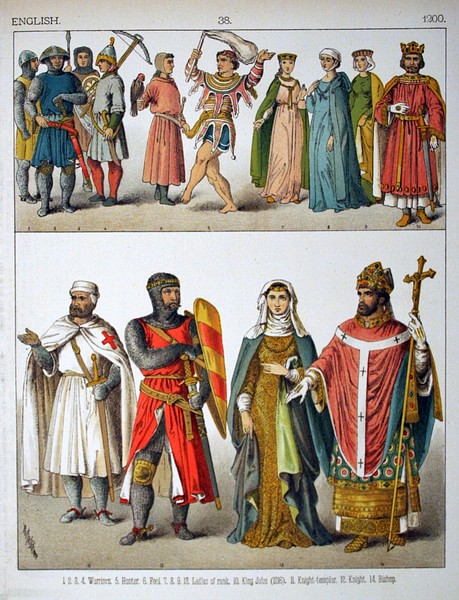
English Medieval Clothing, c. 1200 CE
Materials & Colours
Apparel were generally the same for all classes only with the of import departure of extra ornament, more and finer materials used, and an improved cutting for the wealthier. Additions of metallic, jewels, and fur, or intricate embroidery also distinguished the wardrobe of the rich from that of the poor. Outer dress were not then different between the sexes either except that those for men were shorter and the sleeves roomier. As all apparel were tailor-made, a good fit was guaranteed.
The gustation for colours was the brighter the better, with ruby, blue, xanthous, dark-green & purple being popular choices in all types of clothes.
Clothing was normally fabricated from wool, although silk and brocade items might exist saved for special occasions. Outer clothing fabricated from caprine animal or even camel pilus kept the rich warm in winter. Fur was an obvious way to improve insulation and provide decorative trimmings, the near mutual were rabbit, lambskin, beaver, fox, otter, squirrel, ermine, and sable (the latter three became a standard groundwork design in medieval heraldry such was their common use). More decoration was achieved by adding tassels, fringes, feathers, and embroidered designs, while more expensive additions included precious metallic stitching and buttons, pearls, and cabochons of drinking glass or semi-precious stones. The taste for colours was the brighter the improve, with ruby, blue, yellowish, green and purple beingness the most popular choices in all types of clothes.
Underclothes
Nightwear was not much of a social indicator and did not accept a whole lot of forethought as most people slept naked. After a quick launder with cold water in a basin the get-go thing to put on in the forenoon, at least for the wealthier members of gild, were underclothes, usually made of linen - long-sleeved shirts and drawers for men (down to the genu or below and known as braies) and a long chemise for women.
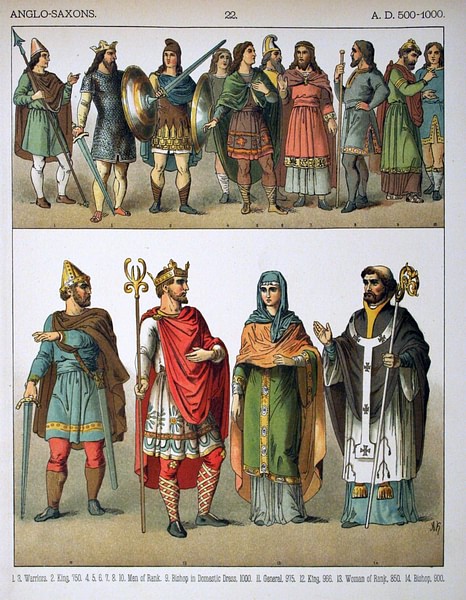
Anglo-Saxon Clothing, half dozen-9th century CE
Both sexes wore long-sleeved tunics which had either a low-cut neck or a slit down the front so they could be put on over the head and then tied at the neck, sometimes with a brooch. The tunic might go down to the knee or even the ankles in the case of more formal wear for the dignity. The longer versions were usually dissever to the waist at the front and dorsum. Most tunics were made in one color, although they might have a different coloured lining. Decorative embroidery was most frequently added at the neck, cuffs and hem, less frequently on the upper arms or all over the garment. A 14th century CE fashion was the jupon or pourpoint, a tight tunic or jacket with padding. The jupon was fastened by buttons or laces all downwards the front and there were sometimes buttons running from the elbow to the wrist; sleeves sometimes reached downwards to the knuckles on these garments.
Outer clothes
On top of the first tunic, another tunic was worn just either without sleeves or with much baggier sleeves; information technology was also shorter at the waist than the undertunic. For colder conditions, these top tunics were ofttimes lined with fur (then chosen a pelisson). A waist belt with decorative metal buckle was worn over the tunic and was the flashiest office of a man's wardrobe, very often with gold, silvery, and jewelled additions.
Illustrations from the Middle Ages ofttimes show quite plain dresses with just a minimal ornamentation.
An culling type of outer tunic was the tabard, cut like a poncho but with the sides airtight by stitching or clasps. Heralds wore a version of the tabard with sleeves only covering the outer arms and the chest busy with the coat of arms of the noble they represented. Once again, the 14th century CE saw a new manner, that of the cote-hardie, a tight jacket with sleeves going only to the elbows, and buttons or laces from the neck right down to the waist (laces were especially fashionable in the twelfth century CE). Tied with a belt, the part beneath the waist billowed out similar a brim, sometimes with a dagged hem. Over time hanging cuffs were added to the sleeves which became longer and a collar was added.
Noble women wore fine dresses, particularly at court and at such social events every bit the medieval tournament. In dissimilarity to later more romantic paintings, illustrations from the Middle Ages oftentimes show quite plain dresses with only a minimal ornament. Typically of a unmarried colour (sometimes with a different coloured lining), they are long, long-sleeved, high-cut, and close-plumbing equipment above a belted waist. Women's belts, almost ever-present in graves and illustrations, sometimes had chains hanging down (chatelaine) to which were fastened small-scale decorative objects (for working women these would take been small tools, useful for such tasks as weaving and embroidery). The most common extra ornamentation is a border at the cuffs and neckline. of the dress. Illustrations oft bear witness tall pointed or flat-topped hats beingness worn with veils hanging downwards, although non covering the face.
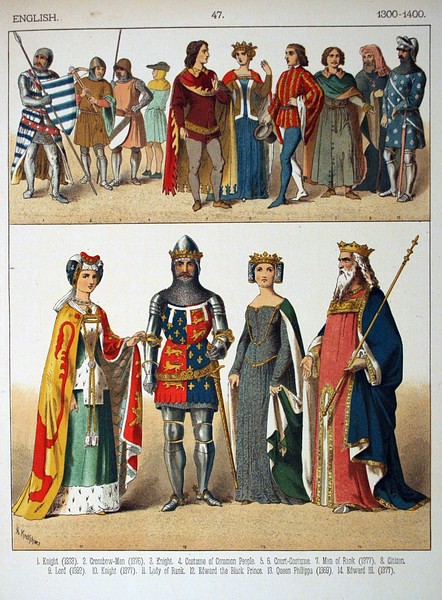
English Medieval Clothing, c. 1300 CE
Men wore hose or long stockings of wool or linen which went up to the articulatio genus or just in a higher place it and which were secured to the chugalug of their drawers. Women'southward stockings were shorter and held up by a garter worn below the genu. Some stockings ended in a stirrup while those which fully enclosed the pes might have a leather sole added to them. Stockings might also be padded to create a fashionable pronounced point at the toes.
Cloaks & Mantles
For going out, a cloak or mantle was worn, which was typically made from a roughly round or rectangular slice of cloth which might, too, be fur-lined. Hither was another adventure for a chip of jewellery as cloaks were fastened with either a chain or brooch at the neck. An alternative fastening was to pull 1 corner of the cloak through a pigsty in the other pinnacle corner and so necktie a knot. A man might spike his cloak at the left shoulder to allow his right arm to freely describe his sword. An alternative to the cloak was a great glaze (garde-corps or herygourd) which stretched downwards to the shins or ankles and had wide sleeves gathered at the shoulder. Both cloaks and great coats might have a hood with some being fastened using a button. An entirely separate hood which also covered the shoulders was an culling for headgear. An culling outer garment from the 14th century CE was the houppelande, a long robe split down the sides from the waist down and with flared sleeves and a high collar.
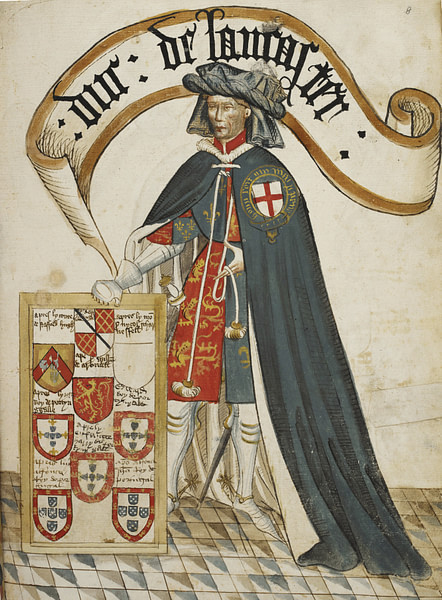
Henry, Knuckles of Lancaster
Gloves, Hats & Footwear
Gloves were worn outdoors and might get almost upwards to the elbow. They also used fur lining and oft had embroidered designs, typically a gold band. Hats were worn by anybody. At home, men wore a linen coif (close-fitting cap) which was tied nether the chin and busy with embroidered designs. Women meanwhile wore a wimple (a headdress which as well covers the neck and sides of the face). Keeping on their indoor headgear, a cap or hood was worn every bit well when outdoors or, when travelling, a hat with a brim that could be turned up at either the dorsum or front. Some hats had a soft and shapeless crown, others were round or had a flat top, and all types could hands be decorated with a couple of ostrich or peacock feathers. From the 14th century CE, hat bands came into style.
Boots, ordinarily quite loose in fitting, were either loftier riding boots or low on the leg (bushkins). Shoes covering the ankle were worn out of doors, and soft sideslip-on slippers in one's private chambers. Shoes, fabricated from textile or leather, were closed via inner laces, a strap or buckle, which was some other opportunity for ornamentation and personalisation. Footwear became increasingly pointed as the Heart Ages wore on, especially for men.
Maintenance
For the elite, there was no worry over the maintenance of their wardrobe every bit that was done past their staff. The chamberlain was (before the part widened and became more important) responsible for his primary'south wardrobe which was kept folded in chests or on pegs ('perches') when not in use. Ladies had their ladies-in-waiting and maids to help them dress. Washing was washed by laundresses who soaked the wearing apparel, or at least the less delicate smalls, in tubs of water mixed with caustic soda and wood ashes, and and then pounded them make clean using wooden paddles.
Social Brandish & Control
As already mentioned, there was not such a distinction betwixt the general style of clothes of unlike classes except in terms of cutting and materials. Notwithstanding, the distinction was a abrupt one, and it was protected by the upper classes, especially when people tried to dress in a higher place their station for personal advocacy. Various sumptuary laws were passed from the 13th century CE onwards which restricted the wearing of sure materials by the lower classes in order to maintain the class divisions of guild. In that location were even limits put on the quantities of such expensive imported materials as furs and luxury cloths like silk for the same purpose. Some other indicator of the relationship between article of clothing and social status is the fact that clothing was considered along with other items of a person's holding to determine their tax obligation, but for the college classes clothing was often left out, suggesting social display was regarded as a necessity for them and an unnecessary luxury for anybody else.
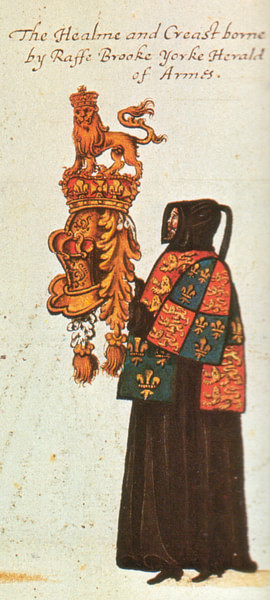
Herald of Artillery
The clergy was i section of society that had more clothing restrictions than most: nuns could not habiliment expensive furs, and members of specific monastic orders had to wear a particular manner of habit to make themselves hands identifiable. Neither could members of the secular clergy adopt certain wider fashions, notably the 13th-century CE shortening of tunics to prove a footling more leg or the use of too many colours in one outfit. Although there is bear witness these rules were frequently ignored, the thought was to maintain the stardom betwixt the clergy and other members of society, particularly knights. There were even measures to distinguish betwixt the faiths, and Jewish clergy, for instance, had to wear two white tablets of linen or parchment on their chests from the mid-13th century CE.
Admission to clothing was also restricted in times of economic strife during wars similar the Hundred Years War with France (1337-1453 CE), presumably to stop wasteful spending. At such times governments, in effect, rationed clothing and then that, for example, priests might only be permitted 1 new robe per year and bishops three. The aforementioned rules applied to aristocratic ladies and knights who could simply have 1 new change of outfit per yr. For the staff in the employ of a local baron or castle-owner, there were differences in the cost, cloth, and colours of the clothes their lord provided them then that there were marked distinctions between such groups as the menial servants, squires, clerks, men-at-artillery, and sergeants.
Vesture remained an important and easily communicated method to display rank and job title. On the battlefield, knights wore chain mail or plate armour with a dash of colour perhaps provided by a surcoat and plumed helmet, but they still had to expect the part of society's ambassadors of knightly even when at leisure. Item robes were worn on special occasions by those with the privileged right to article of clothing them. For example, members of item knights orders such as the Guild of the Garter could habiliment a fine dark blue robe with a gold collar-chain made upward of knots and crimson roses encircled with garters. Clearly, then, in that location were subtle and not so subtle wardrobe distinctions, non only between sure classes simply also within the same class in a continuous game of social display emphasising just who had the right and the means to wearable what and when.
This commodity has been reviewed for accuracy, reliability and adherence to academic standards prior to publication.
0 Response to "Middle Ages and Fashion and Rich"
Post a Comment